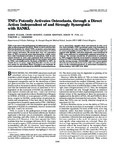TNFα Potently Activates Osteoclasts, through a Direct Action Independent of and Strongly Synergistic with RANKL.
| dc.contributor.author | Fuller, K | |
| dc.contributor.author | Murphy, C | |
| dc.contributor.author | Fox, Simon | |
| dc.contributor.author | Kirstein, B | |
| dc.contributor.author | Chambers, TJ | |
| dc.date.accessioned | 2023-02-15T15:40:26Z | |
| dc.date.available | 2023-02-15T15:40:26Z | |
| dc.date.issued | 2002-03-01 | |
| dc.identifier.issn | 0013-7227 | |
| dc.identifier.issn | 1945-7170 | |
| dc.identifier.uri | http://hdl.handle.net/10026.1/20395 | |
| dc.description.abstract |
<jats:title>Abstract</jats:title><jats:p>TNFα is pivotal to the pathogenesis of inflammatory and possibly postmenopausal osteolysis. Much recent work has clarified mechanisms by which TNFα promotes osteoclastogenesis, but the means by which it activates osteoclasts to resorb bone remain uncertain. We found that very low concentrations of TNFα promoted actin ring formation, which correlates with functional activation in osteoclasts, both in osteoclasts formed in vitro and extracted from newborn rats. TNFα was equipotent with RANKL for this action. Activation by TNFα was unaffected by blockade of RANKL by OPG, its soluble decoy receptor, suggesting that this was due to a direct action on osteoclasts. Bone resorption was similarly directly and potently stimulated, in a RANKL-independent manner in osteoclasts, whether these were formed in vitro or in vivo. Interestingly, TNFα promoted actin ring formation at concentrations an order of magnitude below those required for osteoclastic differentiation. Moreover, TNFα strongly synergized with RANKL, such that miniscule concentrations of TNFα were sufficient to substantially augment osteoclast activation. The extreme sensitivity of osteoclasts to activation by TNFα suggests that the most sensitive osteolytic response of bone to TNFα is through activation of existing osteoclasts; and the strong synergy with RANKL provides a mechanism whereby increased osteolysis can be achieved without disturbance to the underlying pattern of osteoclastic localization.</jats:p> | |
| dc.format.extent | 1108-1118 | |
| dc.format.medium | ||
| dc.language | en | |
| dc.language.iso | en | |
| dc.publisher | The Endocrine Society | |
| dc.subject | Actins | |
| dc.subject | Animals | |
| dc.subject | Bone Marrow Cells | |
| dc.subject | Bone Resorption | |
| dc.subject | Carrier Proteins | |
| dc.subject | Cell Separation | |
| dc.subject | Drug Synergism | |
| dc.subject | Indicators and Reagents | |
| dc.subject | Male | |
| dc.subject | Membrane Glycoproteins | |
| dc.subject | Mice | |
| dc.subject | Osteoclasts | |
| dc.subject | RANK Ligand | |
| dc.subject | Rats | |
| dc.subject | Rats, Wistar | |
| dc.subject | Receptor Activator of Nuclear Factor-kappa B | |
| dc.subject | Spleen | |
| dc.subject | Tumor Necrosis Factor-alpha | |
| dc.title | TNFα Potently Activates Osteoclasts, through a Direct Action Independent of and Strongly Synergistic with RANKL. | |
| dc.type | journal-article | |
| dc.type | Article | |
| plymouth.author-url | https://www.ncbi.nlm.nih.gov/pubmed/11861538 | |
| plymouth.issue | 3 | |
| plymouth.volume | 143 (3) | |
| plymouth.publication-status | Published | |
| plymouth.journal | Endrocrinology | |
| dc.identifier.doi | 10.1210/endo.143.3.8701 | |
| plymouth.organisational-group | /Plymouth | |
| plymouth.organisational-group | /Plymouth/Faculty of Health | |
| plymouth.organisational-group | /Plymouth/Faculty of Health/School of Biomedical Sciences | |
| plymouth.organisational-group | /Plymouth/Research Groups | |
| plymouth.organisational-group | /Plymouth/Research Groups/Institute of Translational and Stratified Medicine (ITSMED) | |
| plymouth.organisational-group | /Plymouth/Research Groups/Institute of Translational and Stratified Medicine (ITSMED)/CBR | |
| plymouth.organisational-group | /Plymouth/Research Groups/Plymouth Institute of Health and Care Research (PIHR) | |
| plymouth.organisational-group | /Plymouth/Users by role | |
| plymouth.organisational-group | /Plymouth/Users by role/Academics | |
| dc.publisher.place | United States | |
| dc.identifier.eissn | 1945-7170 | |
| dc.rights.embargoperiod | Not known | |
| rioxxterms.versionofrecord | 10.1210/endo.143.3.8701 | |
| rioxxterms.licenseref.uri | http://www.rioxx.net/licenses/all-rights-reserved | |
| rioxxterms.type | Journal Article/Review |


